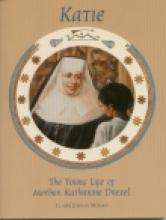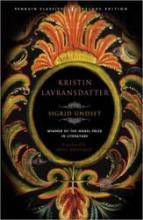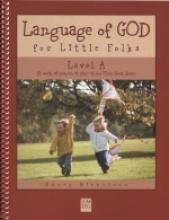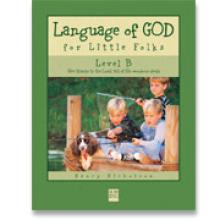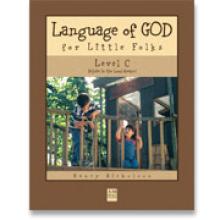No name
Katie: The Young Life of Mother Katherine Drexel
Katherine Mary Drexel (Katie) was born to a wealthy Catholic family of Philadelphia, Pennsylvania, in 1858. As a child she had everything she could wish for - a beautiful playhouse with "carpets, child-size furniture and even a full kitchen." Her parents and her teachers (the sisters from the convent nearby) instilled in her a love for Jesus, and especially the Blessed Sacrament. She struggled with many things familiar to families today - such as trying to understand why she had three sets of grandparents (her own mother died just after Katie was born and her father remarried). The story (which is the style of a first-person narrative - i.e. from the viewpoint of Katie herself) provides warm and personal details about the developing spiritual life of a child which provide an excellent example for young readers in counting their blessings and using their talents for good.
Katie and her two sisters lost their parents when they were still young ladies. Left with a vast fortune, they had to make decisions about suporting charitable organizations. Katie became interested in Missions on American Indian Reservations. Eventually she founded an order of nuns - the Sisters of the Blessed Sacrament. During her lifetime she "opened, staffed, and directly supported nearly sixty schools and missions" and dedicated her life to helping Native and African Americans throughout the United States.
This book includes the story (along with a picture) of two children who prayed to Mother Katherine Drexel for a cure for their little sister. Her miraculous cure was accepted by the Vatican as a true miracle in the investigation process for her canonization. The book also includes many charming black and white photos of Katie and her family, a chronology of her life, and a glossary.
Besides the worthwhile story of a great American saint, the book gives us a glimpse of life in 19th century America. Although many particulars of a Catholic family life are familiar to us today, evidence of the Victorian era are present in instances such as how the nurse explains to the children that their new little sister was brought by angels who visited their mama and papa during the night. The story is charming and gives the reader the feeling that they are really getting to know Mother Drexel very personally. Although I was disappointed with previous writings of Mrs. Mohan (I believe it was because I found the stories too terse, too brief) I thought this story was quite nice and I also appreciate the numerous black and white photos which make for an attractive and appealing book.
King Lear
Kit: An American Girl
This series of six books from the American Girl collection can be enjoyed by young girls even without getting into buying the doll and all her accessories. Set in Ohio in the 1930s, this series focuses on Kit Kittredge and her family who are learning to be more frugal and caring during the tough times of the Great Depression. These are sweet stories and fairly easy for young readers (as young as six or seven years old). The stories are filled with nice little lessons about the things that really matter.
These books can be purchased new from numerous catalogs or warehouse stores but are also readily available in used book stores.
Kristin Lavransdatter
In her great historical epic Kristin Lavransdatter, set in fourteenth-century Norway, Nobel laureate Sigrid Undset tells the life story of one passionate and headstrong woman. Painting a richly detailed backdrop, Undset immerses readers in the day-to-day life, social conventions, and political and religious undercurrents of the period. Now in one volume, Tiina Nunnally’s award-winning definitive translation brings this remarkable work to life with clarity and lyrical beauty. As a young girl, Kristin is deeply devoted to her father, a kind and courageous man. But when as a student in a convent school she meets the charming and impetuous Erlend Nikulaussøn, she defies her parents in pursuit of her own desires. Her saga continues through her marriage to Erlend, their tumultuous life together raising seven sons as Erlend seeks to strengthen his political influence, and finally their estrangement as the world around them tumbles into uncertainty. With its captivating heroine and emotional potency, Kristin Lavransdatter is the masterwork of Norway’s most beloved author—one of the twentieth century’s most prodigious and engaged literary minds—and, in Nunnally’s exquisite translation, a story that continues to enthrall.Seldom do we find such contrasting examples in quality of work as found in the two translations available of Undset’s master work. When we lived near Princeton, NJ, I was challenged to read the trilogy for a Catholic Woman’s Literary group at Aquinas House. My husband offered to buy it for me in Princeton on his way home, and in a good bookstore he found the then-brand-new translation by Tiina Nunnally. I had the opportunity to compare the old Archer translation of the 1930s, which has been continually in print since the 1920s, to this new one. For someone who studied translation in graduate school, this was exhilarating. While the new award winning translation by Nunnally flows in fresh, contemporary style, yet reflective of the historical period, the old one had forced medieval English-isms and felt dry and rusty. In further comparing I noticed that indeed Archer has left entire pages out of the volume—and most especially pages of deep Catholic content. (For readers who have read the second volume, one of the passages left out include the spiritual musings by the heroine upon her arrival at the shrine of St. Olaf during her penitential pilgrimage.) Indeed, the Penguin Classics web page comments:
This new translation by Tina Nunnally—the first English version since Charles Archer's translation in the 1920s—captures Undset's strengths as a stylist. Nunnally, an award-winning translator, retains the natural dialog and lyrical flow of the original Norwegian, with its echoes of Old Norse legends, while deftly avoiding the stilted language and false archaisms of Archer's translation. In addition, she restores key passages left out of that edition.Sigrid Undset converted to the Catholic Church while doing the research for this great historical novel. Daughter of a noted Norwegian archeologist, and fascinated by her father’s field of study, Undset looked to the past as the setting of her greatest novel. In the process of digging Norway’s medieval world she found Catholic Christianity and wholly embraced it. I believe this process of finding one's true meaning in life is behind the superb quality of the story. Some argue that her four volume novel The Master of Hestviken is a more Catholic book because the Christian thought is already present from page one. Maybe so. But alas, no other work by Undset work has the crisp freshness of Kristin Lavransdatter. Undset seems to transfer into her most memorable protagonist the exhilaration of her newfound faith, which caused no small token on her own personal life. As Kristin in the novel, Undset’s own decisions in life, now in the light of her newfound faith, caused many personal sacrifices as well providing the realities redemption and purpose. Again from the Penguin Classics page:
In Kristin Lavransdatter (1920-1922), Sigrid Undset interweaves political, social, and religious history with the daily aspects of family life to create a colorful, richly detailed tapestry of Norway during the fourteenth-century. The trilogy, however, is more than a journey into the past. Undset's own life—her familiarity with Norse sagas and folklore and with a wide range of medieval literature, her experiences as a daughter, wife, and mother, and her deep religious faith—profoundly influenced her writing. Her grasp of the connections between past and present and of human nature itself, combined with the extraordinary quality of her writing, sets her works far above the genre of "historical novels."Few novels are able to remain so wholly in the readers' memories as Kristin Lavransdatter. Sigrid Undset had a gift that is seldom found. This is a story to be savored a paragraph at a time, and a fascinating window into a world that is so foreign and yet it becomes so close in the imagination. Keeping in mind that this novel is best appreciated after the reader has experienced much of life’s vicissitudes, it is still recommended for the high school students. When our daughter read it at the end of freshman year I told her to take note of her impressions and to compare them with her impressions of when she rereads it—hopefully fifteen to twenty years from now. High school students could certainly benefit from reading Kristin Lavransdatter as an important sample of great Catholic fiction. The foreign flavor, in both style and cultural geography, is strongest in the first three chapters and can be a stumbling block, but a good reader will use those three initial chapters to fully immerse themselves into Kristin’s world. The story of love, romance, suffering and redemption will live in their memories. One of the great Catholic element of Kristin Lavransdatter is the lesson of life around which it revolves: because of her initial lack of trust and obedience to her beloved father, Kristin undergoes a lifetime of suffering and pain, finding consolation and redemption only under the shadow of the cross. Few books will teach such a crucial lesson this vividly. Of course, this is a lesson than can be learned at any stage of life, yet lessons are best learned in the formation years of our children. Kristin Lavransdatter is also the Women's Catholic Literary Club par excellence: a challenging yet deeply satisfying read, it could easily dominate an entire semester of meetings' discussions. If you have never hosted one of these, maybe this is the season to do it. Catholic homeschool mothers, I have noticed, enjoy great pleasure in discussing together their thoughts on great Catholic literature, most especially while enjoying a good Port.
The three volumes of this novel were originally published in 1920-22. Nunnally's English translation is copyright 2005.
Also available in this same translation from Penguin Books in three separate volumes.
La Boda: A Mexican Wedding Celebration
Language of God for Little Folks (Level A)
This is a simple and charming, Catholic grammar workbook designed for use in the second grade. It reinforces very basic grammar concepts such as - what constitutes a sentence, nouns and verbs, past and present tense (choosing the correct verb), singular and plural, opposites, simple synonyms, and capitalizing words such as - the days of the week, the months of the year, special titles and the names of God. A complete answer key is included.The book is illustrated with pen and ink drawings (some religious and some charming basic children's pictures) and supplemented with some classic Catholic poetry.
Because there is not a great deal of explanation of how various aspects of grammar work, this works nicely as a supplement to Simply Grammar (reviewed below).
Copyrights 1998/2003/2005
Language of God for Little Folks (Level B)
This simple and charming Catholic workbook provides basic explanations, practices and reinforcement of basic grammar concepts for the third grade. Students practice identifying sentence parts and complete sentences, capitalization, using question marks and "asking words", sentences that command or exclaim, synonyms, antonyms, homonyms, nouns and proper nouns, capitalizing God's the names of God and special titles of Our Lady, singular and plural, possessive nouns, action verbs and "state of being" verbs, past and present tense, helping verbs, verbs that change form, subject and predicate, roots and verb endings, prefixes and suffixes, contractions and abbreviations, syllables, adjectives, pronouns, titles of respect, alphabetizing and the dictionary.
The text includes pen and ink illustrations, Catholic poetry and a complete answer key.
Copyrights 1999/2005
Language of God for Little Folks (Level C)
Language of GOD for Little Folks - Level C, is Catholic Heritage Curricula’s grammar program designed for the third or fourth grader. It is a complete program in a spiral bound workbook and does not require any additional text or teacher’s manual. The program focuses on gradually building language skills. These skills are very naturally presented within the context of the Catholic faith. Topics covered are sentence parts, nouns, verbs, adverbs, adjectives, pronouns, commas, apostrophes, tense, and subject- verb agreement. These topics are all covered in a slightly more challenging manner than in the previous levels.
We have been using CHC’s Language of God program for two years. It presents the information in a regular and comprehensive manner without being needlessly repetitive. Each topic is introduced and the child has the opportunity to practice the necessary skills with reviews included every few lessons. We normally supplement the exercises by discussing the concepts as they apply to our literature and writing assignments. The program is designed to be easy on the teacher and easy on the student without sacrificing quality (speaking plainly, it is easy for me to call out, “Start your grammar.” while attempting to redirect a mischievous toddler and my eight year old begins the lesson joyfully). Furthermore, it teaches grammar while focusing on the ultimate goal of salvation. In the very first lesson it is necessary to read through and discuss several passages from the Gospel. This is a very balanced program for the Catholic homeschooler.
Latin for Beginners (Passport's Language Guides)
In the typical Usborne style, this book offers lots and lots of cartoon-like pictures with Latin dialogue and descriptions and quite a bit of grammar and other tidbits along the way. The pictures are a little goofy (I think they use the same pictures for all the different languages they have out in this series), but the book is packed with content (particularly for the price). This might make an especially nice supplement for grade school students studying Latina Christiana or another early Latin text. Students at this age level will often enjoy writing little notes or dialogues in Latin and this would make a good source of additional vocabulary. It's also fun to have around the house to absorb a little Latin as a family.

